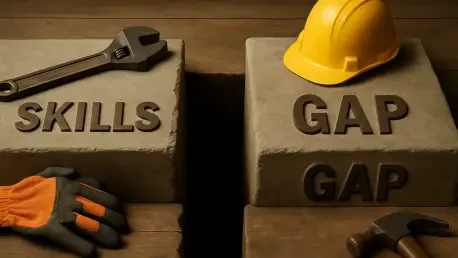The utility sector finds itself at a pivotal moment, facing an unprecedented skills gap that threatens the very foundation of grid reliability and safety, while a wave of seasoned workers retires, taking decades of invaluable expertise with them. The industry must now contend with the rapid integration of cutting-edge technologies like AI-driven inspections and GIS dashboards. This dual challenge of preserving critical knowledge while adapting to digital transformation creates an urgent need for strategic workforce development. The risk of operational disruptions looms large if these gaps are not addressed, with potential consequences for both public safety and economic stability. Yet, within this crisis lies a remarkable opportunity to build a more resilient and innovative utility workforce. By exploring actionable solutions—from upskilling current employees to digitizing institutional know-how—this discussion aims to illuminate a path forward for an industry at a crossroads, ensuring the power stays on for future generations.
Addressing the Loss of Expertise
The departure of veteran utility workers represents a significant loss of institutional knowledge, creating immediate risks for grid operations. Many of these employees have spent decades mastering the intricacies of aging infrastructure and responding to emergencies with a level of intuition that cannot be easily replicated. Their exit leaves a void in practical know-how, particularly in areas like troubleshooting obscure issues or managing equipment under stress. Without a deliberate effort to capture this expertise, utilities face the prospect of costly errors, delayed responses, and even safety hazards. The stakes are high, as the reliability of the power grid hinges on the ability to maintain continuity in operations. Addressing this challenge requires more than just hiring new talent; it demands a proactive approach to preserve the hard-earned lessons of the past while preparing for an increasingly complex future.
Compounding this issue is the rapid pace of technological change, which adds another layer of difficulty for the existing workforce. Tools such as AI analytics and digital mapping systems are becoming indispensable for modern utility operations, yet many long-serving employees lack the training to use them effectively. This mismatch between traditional skills and new demands can lead to inefficiencies, frustration, and even resistance to change among staff. The gap is not merely technical but cultural, as workers accustomed to hands-on methods may view digital solutions with skepticism. Bridging this divide is essential to ensure that the transition to modern systems does not come at the expense of operational stability. Utilities must find ways to integrate these tools in a manner that respects existing expertise while equipping workers with the confidence to adapt, thereby safeguarding both productivity and morale.
Empowering Workers Through Upskilling
One of the most effective strategies to combat the skills gap lies in upskilling veteran workers, leveraging their deep experience while equipping them for a digital era. These employees possess a wealth of practical knowledge about grid maintenance and crisis management, often honed through years of on-the-job challenges. However, without training in modern technologies like GIS dashboards or predictive analytics, their ability to contribute to evolving operations is limited. Tailored programs that focus on blending their existing skills with new digital competencies can transform this workforce into a powerful asset. Such initiatives not only enhance safety and efficiency but also demonstrate a commitment to employee growth, which can significantly boost retention in an industry struggling to keep talent.
Beyond immediate operational benefits, upskilling fosters a culture of adaptability that is crucial for long-term resilience. When workers see that their skills are being updated rather than rendered obsolete, it builds trust and encourages a willingness to embrace innovation. Programs can range from short, focused workshops on specific tools to comprehensive certifications that cover broader digital trends. The key is to design these efforts with accessibility in mind, ensuring that training fits into demanding schedules and addresses real-world needs in the field. Additionally, pairing upskilling with mentorship opportunities allows veteran workers to pass on their insights to newer recruits, creating a knowledge-sharing ecosystem. This approach turns a potential liability into a strength, positioning utilities to navigate both current challenges and future advancements with a capable, confident workforce.
Digitizing Knowledge for Future Generations
Preserving the expertise of retiring workers through digitization stands as a critical step in safeguarding the utility industry’s operational foundation. Much of the know-how that keeps the grid running—such as unique troubleshooting methods or historical context about specific systems—resides solely in the minds of seasoned staff. If left undocumented, this information vanishes with their departure, leaving newer employees to reinvent solutions at great cost in time and resources. By utilizing tools like video walkthroughs, GPS-tagged audio logs, and digital databases of field procedures, utilities can create a permanent repository of knowledge. These resources ensure that critical insights remain accessible, serving as a vital reference for training and day-to-day problem-solving.
The benefits of digitization extend far beyond mere preservation, offering a scalable way to integrate past wisdom into modern workflows. Digital archives can be embedded into training modules, allowing new hires to learn directly from the experiences of their predecessors without needing direct interaction. Furthermore, these tools can be updated over time, ensuring that the knowledge base evolves alongside technological and operational changes. The process also mitigates risks during workforce transitions by providing a consistent source of guidance, reducing the likelihood of errors during high-pressure situations. While the initial investment in digitization may seem daunting, the long-term payoff in efficiency and continuity makes it a strategic necessity. Utilities that prioritize this approach position themselves to maintain high standards of reliability, even as their workforce undergoes significant transformation.
Fostering Collaboration Across Generations
The utility workforce increasingly spans multiple generations, each bringing distinct strengths and challenges to the table, which creates both tension and potential for growth. Veteran employees offer unmatched hands-on experience with infrastructure and emergency protocols, yet they may hesitate to adopt digital tools that feel foreign or unnecessary. Conversely, younger workers often arrive with fluency in technology but lack the practical, field-tested insights needed for complex grid operations. This generational divide can lead to misunderstandings or inefficiencies if not addressed thoughtfully. Creating structures that encourage collaboration, such as cross-generational training teams, can turn these differences into a powerful synergy, blending traditional expertise with modern skills.
Implementing such collaborative approaches requires intentional planning to ensure mutual respect and effective knowledge exchange. Pairing seasoned workers with tech-savvy newcomers in mentorship or joint project settings allows for bidirectional learning, where each group gains from the other’s perspective. For instance, younger employees can assist in navigating digital platforms, while veterans share critical context about equipment behavior under stress. This not only accelerates the adoption of new technologies but also builds a cohesive team dynamic that values diverse contributions. Over time, these efforts help dismantle barriers, fostering a workplace culture where innovation and experience reinforce each other. Utilities that invest in bridging generational gaps stand to gain a more adaptable and unified workforce, ready to tackle the multifaceted demands of a modern grid.
Leadership and Technology Driving Change
Effective leadership plays an indispensable role in steering the utility workforce through the complexities of the skills gap, ensuring that strategies remain grounded in frontline realities. Leaders must maintain a close connection with field crews, understanding their daily challenges and aspirations to tailor development initiatives accordingly. Technology, while a transformative force, needs to be intuitive and designed with end-users in mind to avoid becoming an additional burden. By leveraging data analytics, management can identify specific performance gaps and target training efforts where they are most needed. This data-driven approach, coupled with a commitment to continuous improvement, helps cultivate an environment where workers feel supported and empowered to grow.
Beyond technical solutions, leadership must prioritize building a culture that values adaptability and collaboration over rigid hierarchies. This involves clear communication about the purpose and benefits of new tools, ensuring that employees at all levels understand how these changes enhance their roles rather than threaten them. Additionally, providing accessible feedback channels allows workers to voice concerns or suggest improvements, fostering a sense of ownership in the transformation process. Technology serves as an enabler in this context, amplifying human potential when implemented with care. For example, user-friendly interfaces and on-the-job tech support can ease the transition for less digitally inclined staff. Utilities guided by visionary leadership and purposeful technology integration are better equipped to navigate workforce challenges, securing both operational success and employee satisfaction.
Responding to Industry-Wide Urgency
The utility sector as a whole is awakening to the severity of the workforce crisis, with a growing consensus that proactive investment in human capital is essential for survival. Surveys indicate that a vast majority of global employers plan to prioritize upskilling initiatives over the next few years, reflecting a shared recognition of the stakes involved. The financial implications of unfilled positions, delayed infrastructure projects, and preventable outages are staggering, making workforce development a business imperative rather than a discretionary choice. This trend underscores the need for utilities to act swiftly, aligning their strategies with broader industry movements to avoid falling behind in a competitive landscape.
What sets successful utilities apart is their ability to balance technological innovation with a deep respect for human expertise, ensuring that tools enhance rather than replace workers. The focus is shifting toward evolutionary progress, favoring incremental improvements over untested, sweeping reforms. This approach aligns with the industry’s long-standing emphasis on reliability and trust, particularly given the critical nature of power delivery. Collaboration with educational institutions and tech providers also emerges as a key tactic, offering access to cutting-edge training resources and expertise. As the skills gap manifests in real-time on job sites and in control rooms, the call for action grows louder. Utilities that heed this urgency by investing in their people today will secure a stronger, more capable workforce for the challenges ahead.
Building a Resilient Future
Reflecting on the journey to address the skills gap, utilities have demonstrated a commitment to steady, practical evolution rather than disruptive overhauls. Efforts focused on upskilling veteran staff proved transformative, merging decades of experience with modern digital tools to enhance grid reliability. Digitization initiatives captured irreplaceable knowledge through innovative methods, ensuring that the wisdom of retiring workers continued to guide future operations. Cross-generational collaboration broke down barriers, uniting diverse skill sets into a cohesive force. Leadership played a pivotal role, aligning technology with human needs to foster a culture of continuous growth. Moving forward, the industry must sustain this momentum by scaling training programs, refining digital archives, and deepening partnerships with educational and tech sectors. Prioritizing the human element as the core of utility infrastructure remains the guiding principle, ensuring that the path ahead is built on a foundation of capability, safety, and innovation.









